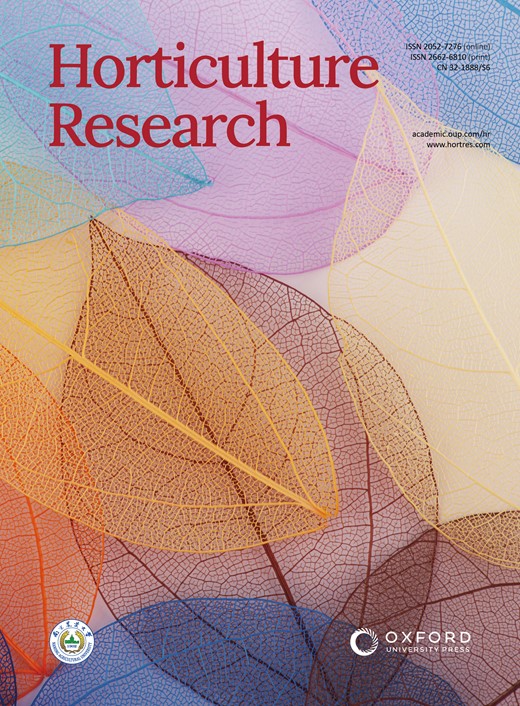A transcription factor, PbWRKY24, contributes to russet skin formation in pear fruits by modulating lignin accumulation
IF 8.7
1区 农林科学
Q1 Agricultural and Biological Sciences
引用次数: 0
Abstract
Skin color is one of the major traits of fruit appearance quality in pear (Pyrus), which affects the fruit commodity value. Russet skin protects pear fruits from environmental stresses and its formation process is closely linked to lignin accumulation. However, the molecular regulatory networks underlying russet skin formation in pear fruits involve complex secondary metabolic pathways and remain elusive. Here, we explored the regulatory mechanisms underlying lignin accumulation in pear skin based on transcriptome sequencing, co-expression network analysis, and gene expression profiling. We identified a WRKY transcription factor gene, PbWRKY24, that regulates russet skin formation in pear fruits. The relative expression of PbWRKY24 in russet pear skin was significantly correlated with lignin content. We then verified the function of PbWRKY24 in lignin accumulation via genetic transformation. DNA affinity purification sequencing revealed that PbWRKY24 directly binds to the promoter of a lignin biosynthesis gene, PbPRX4. This binding was confirmed by yeast one-hybrid, dual-luciferase, and electrophoretic mobility shift assays. Overexpression of PbPRX4 in pear skin stimulated lignin accumulation and consequently promoted russet skin formation. This study provides a glimpse into the intricate lignin biosynthesis mechanisms during russet skin formation in pear fruits, which is of practical significance to pear breeding for fruit quality.转录因子 PbWRKY24 通过调节木质素积累促进梨果赤褐色果皮的形成
果皮颜色是梨果实外观品质的主要特征之一,影响果实的商品价值。赤褐色果皮保护梨果免受环境胁迫,其形成过程与木质素积累密切相关。然而,梨果实中赤褐色果皮形成的分子调控网络涉及复杂的次级代谢途径,仍然难以捉摸。在此,我们基于转录组测序、共表达网络分析和基因表达谱分析,探索了梨皮中木质素积累的调控机制。我们发现了一个 WRKY 转录因子基因 PbWRKY24,它调控梨果实赤褐色果皮的形成。PbWRKY24 在赤皮梨果皮中的相对表达量与木质素含量显著相关。我们随后通过基因转化验证了 PbWRKY24 在木质素积累中的功能。DNA 亲和纯化测序显示,PbWRKY24 直接与木质素生物合成基因 PbPRX4 的启动子结合。酵母单杂交、双荧光素酶和电泳迁移试验证实了这种结合。在梨皮中过表达 PbPRX4 会刺激木质素的积累,从而促进赤褐色果皮的形成。这项研究揭示了梨果实赤褐色果皮形成过程中复杂的木质素生物合成机制,对梨果实品质育种具有重要的现实意义。
本文章由计算机程序翻译,如有差异,请以英文原文为准。
求助全文
约1分钟内获得全文
求助全文
来源期刊

Horticulture Research
Biochemistry, Genetics and Molecular Biology-Biochemistry
CiteScore
11.20
自引率
6.90%
发文量
367
审稿时长
20 weeks
期刊介绍:
Horticulture Research, an open access journal affiliated with Nanjing Agricultural University, has achieved the prestigious ranking of number one in the Horticulture category of the Journal Citation Reports ™ from Clarivate, 2022. As a leading publication in the field, the journal is dedicated to disseminating original research articles, comprehensive reviews, insightful perspectives, thought-provoking comments, and valuable correspondence articles and letters to the editor. Its scope encompasses all vital aspects of horticultural plants and disciplines, such as biotechnology, breeding, cellular and molecular biology, evolution, genetics, inter-species interactions, physiology, and the origination and domestication of crops.
 求助内容:
求助内容: 应助结果提醒方式:
应助结果提醒方式:


